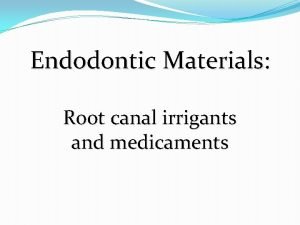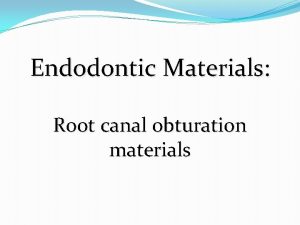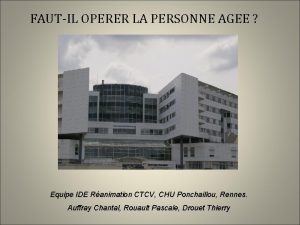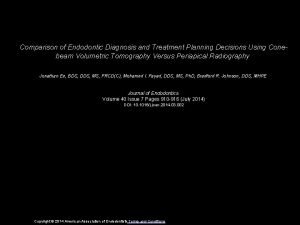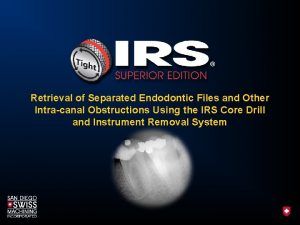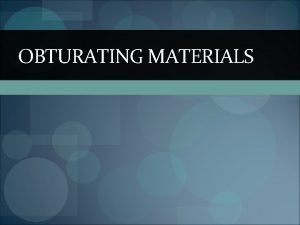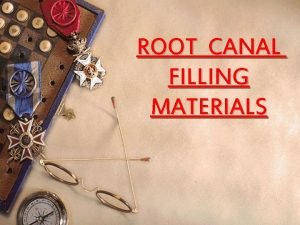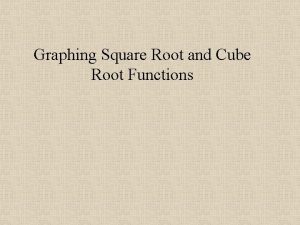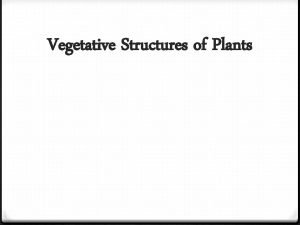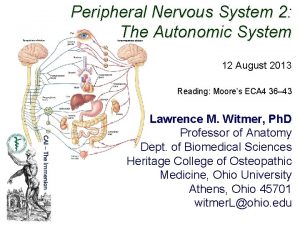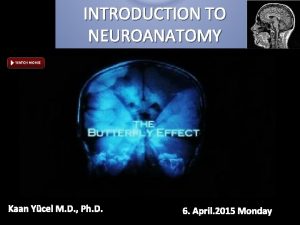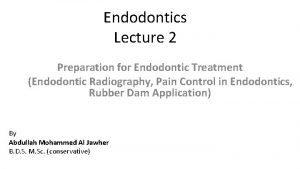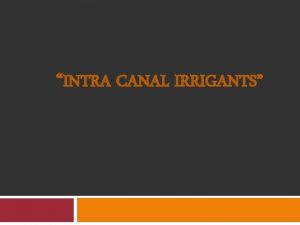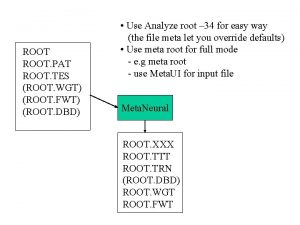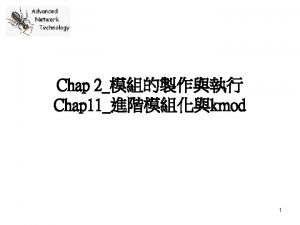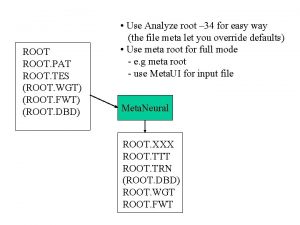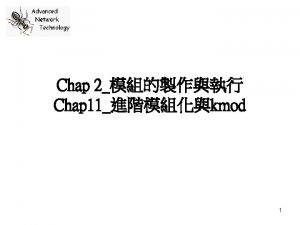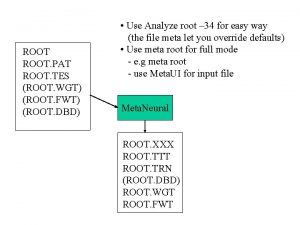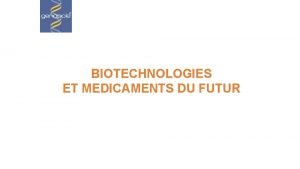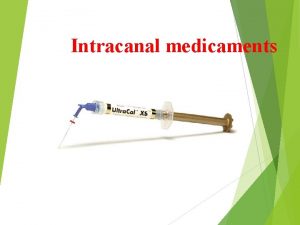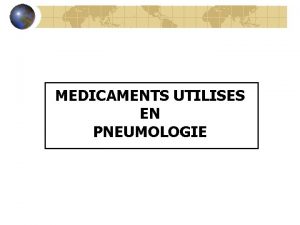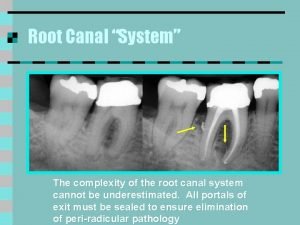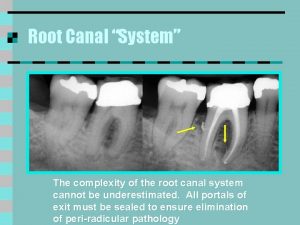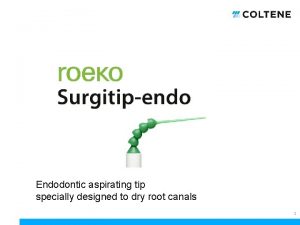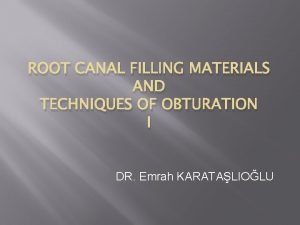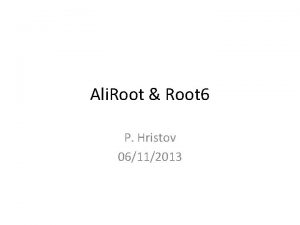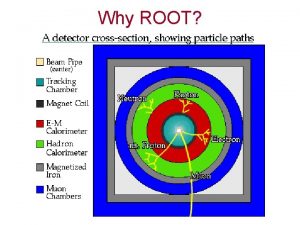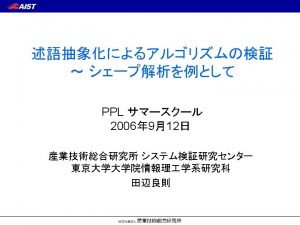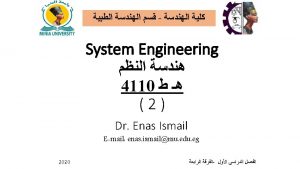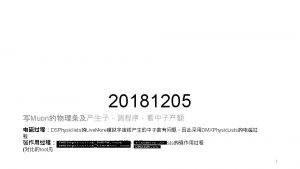Endodontic Materials Root canal irrigants and medicaments The
































- Slides: 32

Endodontic Materials: Root canal irrigants and medicaments

The main objectives of root canal therapy are: • Removal of the pathologic pulp. • Cleaning and shaping of the root canal system. • Three dimensional obturation to prevent reinfection.





There is no definitive evidence in the literature to show that mechanical instrumentation alone will predictably result in bacteria-free root canal systems. Irrigation is an essential part of root canal debridement because it allows for cleaning beyond what might be achieved by root canal instrumentation alone.

Disinfection of the root canal system is one of the primary aims of root canal treatment. This can be achieved through the use of various antimicrobial agents in the form of irrigants (only used for relatively short periods of time) and medicaments (days or several weeks).

Irrigants �Ideal properties: �Lubricant �Antimicrobial �Dissolve organic debris �Flushing �Biocompatible �Cheap

Functions of irrigants � Irrigants are used to clean the root canal and are used in association with the shaping instruments. � Functions of irrigants include: 1. Lubrication of instruments used to shape the canal. 2. Flushing out of gross debris. 3. Dissolution of organic and inorganic tissue. 4. Antimicrobial effect.

Classification of irrigants �Chemically inactive irrigants �Water �Saline �Local anaesthetic solution �Chemically active irrigants �Sodium hypochlorite (Na. OCl). �Oxidizing agents as Hydrogen peroxide (H 2 O 2) �Chelating agents as EDTA.

Sodium hypochlorite � 0. 5 -5. 25 % �Antibacterial and antifungal. �Excellent tissue dissolving ability. �Heat may enhance efficiency. �Has deteriorative effects on mechanical properties of dentine. �Apical reaction �Rubber dam


Hydrogen peroxide � 3% +/- Na. OCl �Production of O 2 eliminate anaerobes �Bubbles may prevent adequate contact of irrigant with debris �Limited shelf life

Chlorhexidine �Hibisrcub �Usually effective in 2% concentration. �Antibacterial and antifungal. �Substantivity up to 12 weeks. �Flushing �Lubricant �Does not dissolve organic debris. �Should be used as a final rinse.

Chelating agent �Ethylene Diamine Tetracetic Acid “EDTA” (File-eze, RC Prep) �Remove smear layer allowing cleaning of tubules �Soften dentine �Not antibacterial �File-eze is water soluble unlike RC Prep which contains carbowax and is difficult to remove

Bio. Pure (MTAD) • Introduced by Torabinejad et al. in 2003. • Mixture of 3% doxycycline, 4. 25% citric acid and a detergent (0. 5% Polysorbate 80). • MTAD is able to remove the smear layer and is effective against E. faecalis. • Shows substantivity up to 4 weeks.



Irrigants �Sterile water �Local anaesthetic �Saline (0. 9%) They only provide lubrication and gross debris removal functions.

Irrigants have to be used in large volumes and to be confined to root canal space. Never to be delivered with excessive force. Best Irrigation protocol is the alternating use of Na. OCl with EDTA or Bio. Pure. CHX can be used as a final rinse.

Irrigation Delivery and Agitation techniques: A-Manual Techniques: 1. Syringe irrigation with needles: passively or with agitation. Irrigant delivered distally or laterally. 2. Brushes: for irrigant agitation and debridement of root canal wall. 3. Manual-dynamic irrigation: well-fitted gutta percha cone.

B-Machine-assisted Techniques: 1. Rotary brushes. 2. Continuous irrigation during rotary instrumentation. 3. Sonic irrigation. 4. Ultrasonic irrigation.

Intracanal medicaments If root canal treatment can’t be finished in a single visit, root canals are dressed with medicaments. A medicament is an antimicrobial agent that is placed inside the root canal between treatment appointments in an attempt to destroy remaining microorganisms and prevent reinfection.

Functions of intracanal medicaments: Primary function: antimicrobial activity Antisepsis Disinfection Secondary functions Hard-tissue formation Pain control Exudation control Resorption control

Intracanal medicament �Ideal properties � Antibacterial � Penetrates dentinal tubules � Control exudation or bleeding � Biocompatibile. � Eliminates pain � Induce calcific barrier � No effect on temporary � Radio-opaque � Does not stain tooth

The clinical effectiveness of these agents must be evaluated in the light of the complexity of root canal anatomy and polymicrobial nature of root canal infections.

Root canal preparation, with careful disinfection and use of intracanal substances that provide good antimicrobial efficacy, tissue dissolution capacity, and acceptable biocompatibility, will definitely improve the prognosis of the treatment of apical periodontitis. The antimicrobial efficacy of intracanal medicaments on bacterial biofilms still need to be confirmed.

Calcium hydroxide Hypocal Antibacterial (p. H>12) Denatures protein Synergestic with Na. OCL Cytotoxic-local necrosis, calcific barrier Cheap Dries weeping canals Forms a calcific barrier

Antibiotics �Tetracyclines have been used to remove the smear layer from instrumented root canal walls, for irrigation of retrograde cavities during periapical surgical procedures , and as an intracanal medicament. �Combination of drugs required to be effective �Resistant strains becoming more difficult to treat �Allergies.

Steroids Triamicinolone, prednisolone Pain relief but no evidence of more effective than Ca(OH)2 ? use in root resorption by inhibiting odontoclasts ? depresses the host inflammatory response Not antibacterial but can be mixed with Ca(OH)2 Ledermix= triamicinolone+ tetracycline

CHX Owing to the greater activity against Gram-positive than Gram-negative organisms, application of CHX as intracanal medicament is preferred in retreatment case compared with initial endodontic infections.
 Intracanal medicaments
Intracanal medicaments Obturation materials in endodontics
Obturation materials in endodontics Dragonal médicaments
Dragonal médicaments Endodontic diagnosis and treatment planning
Endodontic diagnosis and treatment planning Spreaders and pluggers ppt
Spreaders and pluggers ppt Irs kit endo
Irs kit endo Gutta percha phases
Gutta percha phases Formula de blasius
Formula de blasius Endofill root canal sealer
Endofill root canal sealer Angelo sargenti technique
Angelo sargenti technique Endoclub
Endoclub Cant stop the feeling trolls go noodle
Cant stop the feeling trolls go noodle 5 useful and harmful materials
5 useful and harmful materials Man made map
Man made map Adopting and adapting teaching materials
Adopting and adapting teaching materials Direct materials budget with multiple materials
Direct materials budget with multiple materials Pine leaves
Pine leaves Graphing cube root functions
Graphing cube root functions Primary root and secondary root
Primary root and secondary root Parietal mesoderm
Parietal mesoderm Dendirites
Dendirites Hình ảnh bộ gõ cơ thể búng tay
Hình ảnh bộ gõ cơ thể búng tay Lp html
Lp html Bổ thể
Bổ thể Tỉ lệ cơ thể trẻ em
Tỉ lệ cơ thể trẻ em Voi kéo gỗ như thế nào
Voi kéo gỗ như thế nào Glasgow thang điểm
Glasgow thang điểm Hát lên người ơi
Hát lên người ơi Môn thể thao bắt đầu bằng từ chạy
Môn thể thao bắt đầu bằng từ chạy Thế nào là hệ số cao nhất
Thế nào là hệ số cao nhất Các châu lục và đại dương trên thế giới
Các châu lục và đại dương trên thế giới Công thức tính độ biến thiên đông lượng
Công thức tính độ biến thiên đông lượng Trời xanh đây là của chúng ta thể thơ
Trời xanh đây là của chúng ta thể thơ
